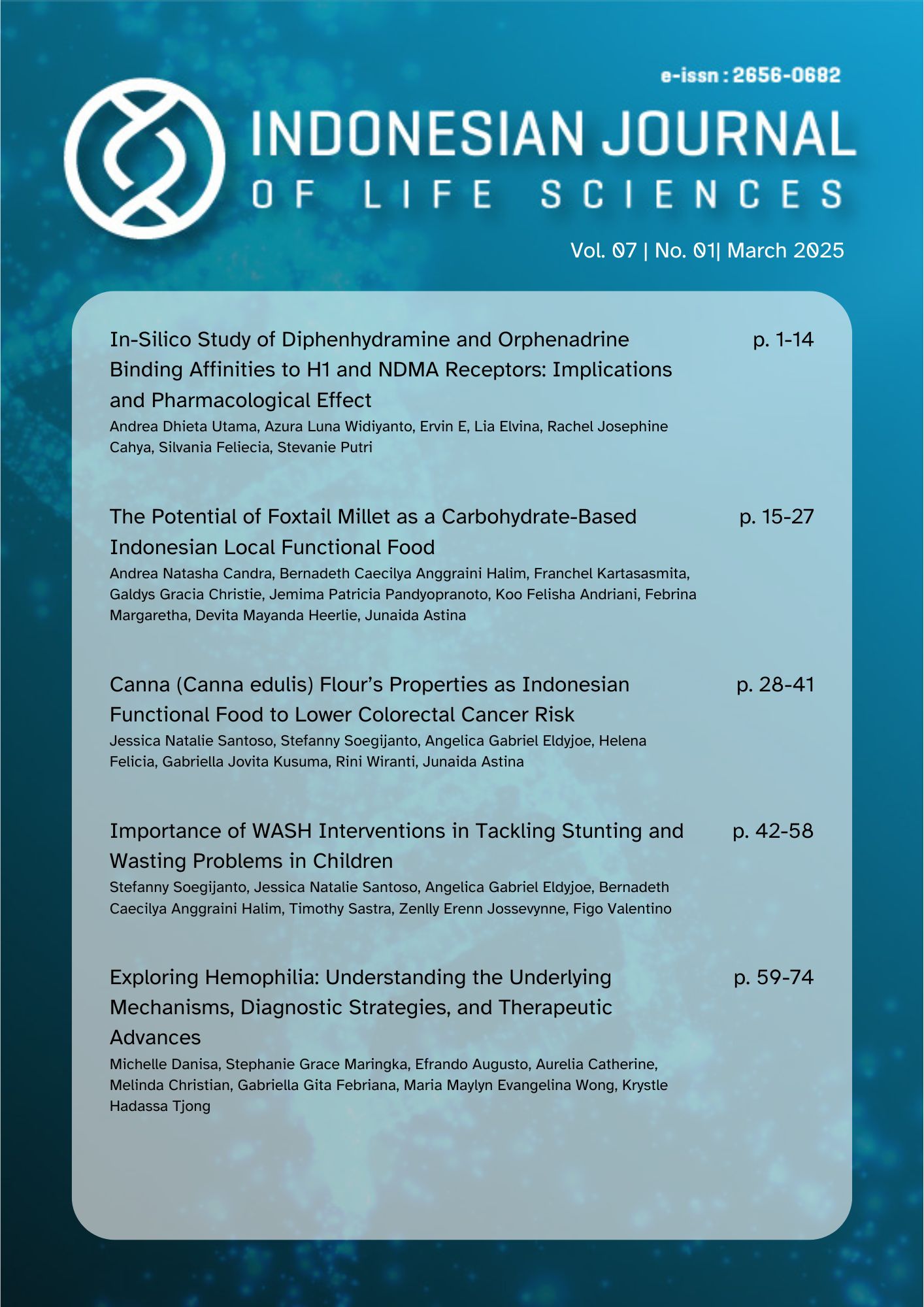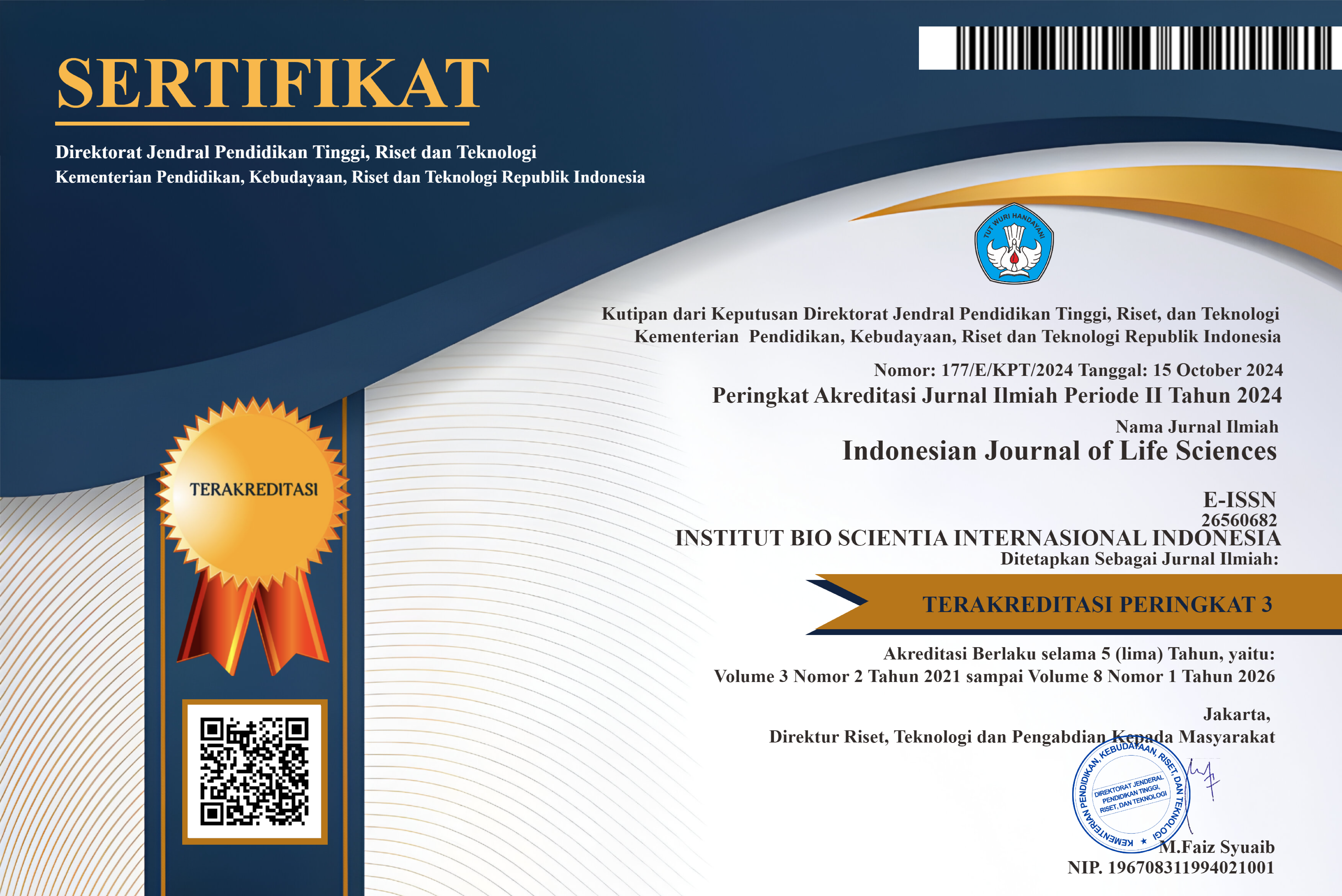Exploring Hemophilia: Understanding the Underlying Mechanisms, Diagnostic Strategies, and Therapeutic Advances
Abstract
Hemophilia is an inherited blood disorder resulting in impaired blood clotting upon vascular damage due to defective or deficient coagulation factors. The three types of hemophilia are hemophilia A, hemophilia B, and hemophilia C, which result from the defect or deficiency of factor VIII, factor IX, and factor XI respectively. Hemophilia affects hundreds of millions of people worldwide, with the highest incidence in Asian countries including India, Bangladesh, and Indonesia. This review encompasses the epidemiology, etiology, pathophysiology, diagnosis, and treatment for hemophilia, and the literature sources were collected from other publications, including journal articles and books.
Downloads
References
Alghamdi, M. A., Almubarak, A. O., Alsedrani, N., Alshehri, W. M., & Alturki, A. Y. (2019). Pretruncal Nonaneurysmal Subarachnoid Hemorrhage with Underlying Hemophilia C. World Neurosurgery, 127, 109–112. https://doi.org/10.1016/j.wneu.2019.03.278
Amoozgar, H., Fath, M., Jooya, P., & Karimi, M. (2017). Evaluation of Heart Function in Patients With Hemophilia. Clinical and Applied Thrombosis/Hemostasis, 23(4), 374–378. https://doi.org/10.1177/1076029615614394
Aria, M., Erten, A., & Yalcin, O. (2019). Technology Advancements in Blood Coagulation Measurements for Point-of-Care Diagnostic Testing. Frontiers in Bioengineering and Biotechnology, 7, 395. https://doi.org/10.3389/fbioe.2019.00395
Barbosa, M., & Martins, C. M. L. (2017). Peptides and Proteins as Biomaterials for Tissue Regeneration and Repair (Woodhead Publishing Series in Biomaterials) (1st ed.). Woodhead Publishing.
Bowyer, A. E., Duncan, E. M., & Antovic, J. P. (2018). Role of chromogenic assays in haemophilia A and B diagnosis. Haemophilia, 24(4), 578–583. https://doi.org/10.1111/hae.13520
Castaman, G., & Matino, D. (2019). Hemophilia A and B: Molecular and clinical similarities and differences. Haematologica, 104(9), 1702–1709. https://doi.org/10.3324/haematol.2019.221093
Davidoff, A. M., & Nathwani, A. C. (2016). Genetic Targeting of the Albumin Locus to Treat Hemophilia. New England Journal of Medicine, 374(13), 1288–1290. https://doi.org/10.1056/NEJMcibr1600347
De Brasi, C., El-Maarri, O., Perry, D. J., Oldenburg, J., Pezeshkpoor, B., & Goodeve, A. (2014). Genetic testing in bleeding disorders. Haemophilia, 20, 54–58. https://doi.org/10.1111/hae.12409
Eckhardt, C. L., Van Velzen, A. S., Peters, M., Astermark, J., Brons, P. P., Castaman, G., … Fijnvandraat, K. (2013). Factor VIII gene (F8) mutation and risk of inhibitor development in nonsevere hemophilia A. Blood, 122(11), 1954–1962. https://doi.org/10.1182/blood-2013-02-483263
El Ekiaby, M., Burnouf, T., Goubran, H., Radosevich, M., & El Ekiaby, A. (2018). Role of the mini-pool cryoprecipitate technology for cost-saving and guarantee of local Factor VIII, Von Willebrand Factor and Fibrinogen product supply: Egypt experience. Annals of Blood, 3, 22–22. https://doi.org/10.21037/aob.2018.02.07
Franchini, M., & Mannucci, P. (2012). Past, present and future of hemophilia: A narrative review. Orphanet Journal of Rare Diseases, 7(1), 24. https://doi.org/10.1186/1750-1172-7-24
Franchini, M., & Mannucci, P. M. (2011). Inhibitors of propagation of coagulation (factors VIII, IX and XI): A review of current therapeutic practice: Inhibitors of factors VIII, IX and XI. British Journal of Clinical Pharmacology, 72(4), 553–562. https://doi.org/10.1111/j.1365-2125.2010.03899.x
Goodeve, A. C. (2015). Hemophilia B: Molecular pathogenesis and mutation analysis. Journal of Thrombosis and Haemostasis, 13(7), 1184–1195. https://doi.org/10.1111/jth.12958
Gualtierotti, R., Pasca, S., Ciavarella, A., Arcudi, S., Giachi, A., Garagiola, I., … Peyvandi, F. (2022). Updates on Novel Non-Replacement Drugs for Hemophilia. Pharmaceuticals, 15(10), 1183. https://doi.org/10.3390/ph15101183
Hartmann, J., & Croteau, S. E. (2016). 2017 Clinical trials update: Innovations in hemophilia therapy. American Journal of Hematology, 91(12), 1252–1260. https://doi.org/10.1002/ajh.24543
Hirayama, A. B., Silva, A. K. C. D., Rocha, J. S., & Roberti, M. D. R. F. (2019). Prevalence of symptoms in hemophilia carriers in comparison with the general population: A systematic review. Hematology, Transfusion and Cell Therapy, 41(4), 349–355. https://doi.org/10.1016/j.htct.2019.02.006
Huether, S. E., McCance, K. L., Parkinson, C. F., Brashers, V. L., & Rote, N. S. (2022). Study Guide for Understanding Pathophysiology (5th ed.). Elsevier Saunders.
Indonesian Ministry of Health. (2021). Keputusan Menteri Kesehatan tentang Pedoman Nasional Pelayanan Kedokteran Tata Laksana Hemofilia [HK.01.07/MENKES/243/2021]. Kementerian Kesehatan Indonesia.
Iorio, A., Stonebraker, J. S., Chambost, H., Makris, M., Coffin, D., Herr, C., … for the Data and Demographics Committee of the World Federation of Hemophilia. (2019). Establishing the Prevalence and Prevalence at Birth of Hemophilia in Males: A Meta-analytic Approach Using National Registries. Annals of Internal Medicine, 171(8), 540. https://doi.org/10.7326/M19-1208
Ishii, E. (2018). Hematological Disorders in Children: Pathogenesis and Treatment. Springer.
Jamil, M. A., Sharma, A., Nuesgen, N., Pezeshkpoor, B., Heimbach, A., Pavlova, A., … El-Maarri, O. (2019). F8 Inversions at Xq28 Causing Hemophilia A Are Associated With Specific Methylation Changes: Implication for Molecular Epigenetic Diagnosis. Frontiers in Genetics, 10, 508. https://doi.org/10.3389/fgene.2019.00508
Jankowska, K. I., McGill, J., Pezeshkpoor, B., Oldenburg, J., Sauna, Z. E., & Atreya, C. D. (2020). Further Evidence That MicroRNAs Can Play a Role in Hemophilia A Disease Manifestation: F8 Gene Downregulation by miR-19b-3p and miR-186-5p. Frontiers in Cell and Developmental Biology, 8, 669. https://doi.org/10.3389/fcell.2020.00669
Jayakrishnan, T., Shah, D., & Mewawalla, P. (2019). Hemophilia C: A Case Report With Updates on Diagnosis and Management of a Rare Bleeding Disorder. Journal of Hematology, 8(3), 144–147. https://doi.org/10.14740/jh522
Jeanpierre, E., Pouplard, C., Lasne, D., Le Cam Duchez, V., Eschwege, V., Flaujac, C., … Voyer, A. (2020). Factor VIII and IX assays for post‐infusion monitoring in hemophilia patients: Guidelines from the French BIMHO group (GFHT). European Journal of Haematology, 105(2), 103–115. https://doi.org/10.1111/ejh.13423
Kato, A., Asakai, R., Davie, E. W., & Aoki, N. (1989). Factor XI gene (F11) is located on the distal end of the long arm of human chromosome 4. Cytogenetic and Genome Research, 52(1–2), 77–78. https://doi.org/10.1159/000132844
Key, N. S. (2004). Inhibitors in congenital coagulation disorders: Review. British Journal of Haematology, 127(4), 379–391. https://doi.org/10.1111/j.1365-2141.2004.05168.x
Kitazawa, T., Igawa, T., Sampei, Z., Muto, A., Kojima, T., Soeda, T., … Hattori, K. (2012). A bispecific antibody to factors IXa and X restores factor VIII hemostatic activity in a hemophilia A model. Nature Medicine, 18(10), 1570–1574. https://doi.org/10.1038/nm.2942
Knobe, K., & Berntorp, E. (2011). Haemophilia and Joint Disease: Pathophysiology, Evaluation, and Management. Journal of Comorbidity, 1(1), 51–59. https://doi.org/10.15256/joc.2011.1.2
Knobe, K., & Berntorp, E. (2012). New treatments in hemophilia: Insights for the clinician. Therapeutic Advances in Hematology, 3(3), 165–175. https://doi.org/10.1177/2040620712440007
Kruse-Jarres, R., Kempton, C. L., Baudo, F., Collins, P. W., Knoebl, P., Leissinger, C. A., … Kessler, C. M. (2017). Acquired hemophilia A: Updated review of evidence and treatment guidance: KRUSE-JARRES et al. American Journal of Hematology, 92(7), 695–705. https://doi.org/10.1002/ajh.24777
Lannoy, N., & Hermans, C. (2010). The ‘royal disease’- haemophilia A or B? A haematological mystery is finally solved: THE ROYAL DIESEASE. Haemophilia, 16(6), 843–847. https://doi.org/10.1111/j.1365-2516.2010.02327.x
Mannucci, P. M. (2020). Hemophilia therapy: The future has begun. Haematologica, 105(3), 545–553. https://doi.org/10.3324/haematol.2019.232132
Mansouritorghabeh, H. (2015). Clinical and laboratory approaches to hemophilia a. Iranian Journal of Medical Sciences, 40(3), 194–205.
Mantik, M. F. J., Gunawan, S., & Wowiling, S. (2020). Knowledge about hemophilia among teachers of patients with hemophilia in Indonesia. Pediatric Hematology Oncology Journal, 5(3), 126–129. https://doi.org/10.1016/j.phoj.2020.06.003
Matuk-Villazon, O., Roberts, J. C., & Corrales-Medina, F. F. (2021). Hemophilia: The Past, the Present, and the Future. Pediatrics In Review, 42(12), 672–683. https://doi.org/10.1542/pir.2020-004143
Meeks, S. L., & Batsuli, G. (2016). Hemophilia and inhibitors: Current treatment options and potential new therapeutic approaches. Hematology, 2016(1), 657–662. https://doi.org/10.1182/asheducation-2016.1.657
Nathwani, A. C. (2019). Gene therapy for hemophilia. Hematology, 2019(1), 1–8. https://doi.org/10.1182/hematology.2019000007
Nogami, K., & Shima, M. (2019). New therapies using nonfactor products for patients with hemophilia and inhibitors. Blood, 133(5), 399–406. https://doi.org/10.1182/blood-2018-07-820712
Payne, A. B., Miller, C. H., Kelly, F. M., Soucie, J. M., & Hooper, W. C. (2013). The CDC Hemophilia A Mutation Project (CHAMP) Mutation List: A New Online Resource. Human Mutation, 34(2), E2382–E2392. https://doi.org/10.1002/humu.22247
Peyvandi, F., Kenet, G., Pekrul, I., Pruthi, R. K., Ramge, P., & Spannagl, M. (2020). Laboratory testing in hemophilia: Impact of factor and non‐factor replacement therapy on coagulation assays. Journal of Thrombosis and Haemostasis, 18(6), 1242–1255. https://doi.org/10.1111/jth.14784
Pipe, S. W., Montgomery, R. R., Pratt, K. P., Lenting, P. J., & Lillicrap, D. (2016). Life in the shadow of a dominant partner: The FVIII-VWF association and its clinical implications for hemophilia A. Blood, 128(16), 2007–2016. https://doi.org/10.1182/blood-2016-04-713289
Polderdijk, S. G. I., Adams, T. E., Ivanciu, L., Camire, R. M., Baglin, T. P., & Huntington, J. A. (2017). Design and characterization of an APC-specific serpin for the treatment of hemophilia. Blood, 129(1), 105–113. https://doi.org/10.1182/blood-2016-05-718635
Potgieter, J. J., Damgaard, M., & Hillarp, A. (2015). One-stage vs. Chromogenic assays in haemophilia A. European Journal of Haematology, 94, 38–44. https://doi.org/10.1111/ejh.12500
Rallapalli, P. M., Kemball‐Cook, G., Tuddenham, E. G., Gomez, K., & Perkins, S. J. (2013). An interactive mutation database for human coagulation factor IX provides novel insights into the phenotypes and genetics of hemophilia B. Journal of Thrombosis and Haemostasis, 11(7), 1329–1340. https://doi.org/10.1111/jth.12276
Rodríguez-Merchán, E. C., De Pablo-Moreno, J. A., & Liras, A. (2021). Gene Therapy in Hemophilia: Recent Advances. International Journal of Molecular Sciences, 22(14), 7647. https://doi.org/10.3390/ijms22147647
Rodríguez-Merchán, E. C., & Jiménez-Yuste, V. (2022). Pathophysiology of Hemophilia. In E. C. Rodríguez-Merchán (Ed.), Advances in Hemophilia Treatment (pp. 1–9). Cham: Springer International Publishing. https://doi.org/10.1007/978-3-030-93990-8_1
Saba, H. I., & Roberts, H. R. (2014). Hemostasis and Thrombosis: Practical Guidelines in Clinical Management (1st ed.). Wiley-Blackwell.
Sahu, S., Lata, I., Singh, S., & Kumar, M. (2011). Revisiting hemophilia management in acute medicine. Journal of Emergencies, Trauma, and Shock, 4(2), 292. https://doi.org/10.4103/0974-2700.82225
Shen, G., Gao, M., Cao, Q., & Li, W. (2022). The Molecular Basis of FIX Deficiency in Hemophilia B. International Journal of Molecular Sciences, 23(5), 2762. https://doi.org/10.3390/ijms23052762
Sokal, E. M., Lombard, C., & Mazza, G. (2015). Mesenchymal stem cell treatment for hemophilia: A review of current knowledge. Journal of Thrombosis and Haemostasis, 13, S161–S166. https://doi.org/10.1111/jth.12933
Tantawy, A. A. G. (2010). Molecular genetics of hemophilia A: Clinical perspectives. Egyptian Journal of Medical Human Genetics, 11(2), 105–114. https://doi.org/10.1016/j.ejmhg.2010.10.005
Tokugawa, T. (2020). Diagnosis and treatment of hemophilia. 61(9), 1338–1348. https://doi.org/10.11406/rinketsu.61.1338
Trakymiene, S. S., & Carlsson, K. S. (2014). On-demand treatment in persons with severe haemophilia. European Journal of Haematology, 93, 39–47. https://doi.org/10.1111/ejh.12373
Weyand, A. C., & Pipe, S. W. (2019). New therapies for hemophilia. Blood, 133(5), 389–398. https://doi.org/10.1182/blood-2018-08-872291
Zimmermann, M. A., Oldenburg, J., Müller, C. R., & Rost, S. (2011). Unusual genomic rearrangements in introns 1 and 22 of the F8 gene. Hamostaseologie, 31 Suppl 1, S69-73.
Zimta, A.-A., Hotea, I., Brinza, M., Blag, C., Iluta, S., Constantinescu, C., … Tomuleasa, C. (2021). The Possible Non-Mutational Causes of FVIII Deficiency: Non-Coding RNAs and Acquired Hemophilia A. Frontiers in Medicine, 8, 654197. https://doi.org/10.3389/fmed.2021.654197
Zwagemaker, A., Kloosterman, F. R., Coppens, M., Gouw, S. C., Boyce, S., Bagot, C. N., … Fijnvandraat, K. (2022). Desmopressin for bleeding in non‐severe hemophilia A: Suboptimal use in a real‐world setting. Research and Practice in Thrombosis and Haemostasis, 6(6), e12777. https://doi.org/10.1002/rth2.12777

This work is licensed under a Creative Commons Attribution-NonCommercial-ShareAlike 4.0 International License.
Articles published in Indonesian Journal Life of Sciences are licensed under a Creative Commons Attribution-ShareAlike 4.0 International license. You are free to copy, transform, or redistribute articles for any lawful purpose in any medium, provided you give appropriate credit to the original author(s) and Indonesian Journal Life of Sciences, link to the license, indicate if changes were made, and redistribute any derivative work under the same license. Copyright on articles is retained by the respective author(s), without restrictions. A non-exclusive license is granted to Indonesian Journal Life of Sciences to publish the article and identify itself as its original publisher, along with the commercial right to include the article in a hardcopy issue for sale to libraries and individuals. By publishing in Indonesian Journal Life of Sciences, authors grant any third party the right to use their article to the extent provided by the Creative Commons Attribution-ShareAlike 4.0 International license.










